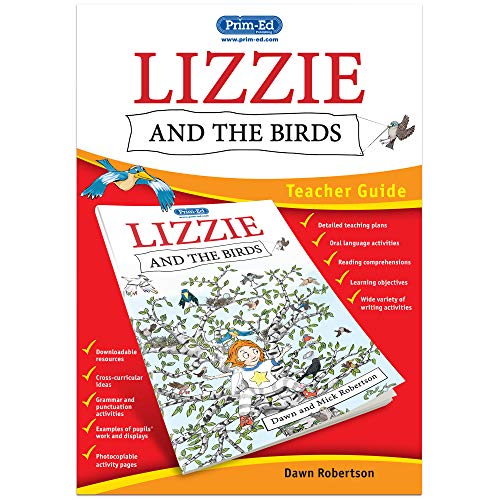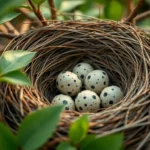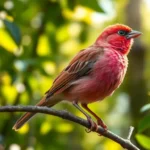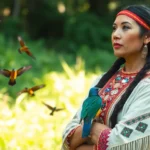When we look up at the sky and spot a bird gracefully soaring through the air we’re witnessing one of nature’s most remarkable engineering feats. Bird feathers aren’t just beautiful – they’re incredibly complex structures that enable flight while providing insulation waterproofing and even communication tools.
We often take these natural marvels for granted but feathers represent millions of years of evolutionary perfection. From the tiniest hummingbird to the largest eagle each feather serves multiple purposes that keep birds alive and thriving in diverse environments worldwide.
Understanding how feathers work opens up a intriguing area of biology physics and natural design. Whether you’re a bird enthusiast nature lover or simply curious about the industry around you discovering the secrets behind these incredible structures will change how you view every bird you encounter.
The Anatomy and Structure of Bird Feathers
Bird feathers represent one of nature’s most sophisticated structural designs, combining lightweight materials with remarkable strength and versatility. Each feather functions as a complex engineering marvel that enables birds to achieve their diverse biological needs.
Feather Types and Their Functions
Contour feathers form the outer layer of plumage and create the bird’s streamlined silhouette for efficient flight. These feathers contain a central shaft called a rachis with symmetrical vanes extending outward, providing the aerodynamic surfaces essential for lift and maneuverability.
Down feathers trap warm air close to the bird’s body through their fluffy, three-dimensional structure. We find these beneath the contour feathers, where they create insulating air pockets that maintain optimal body temperature in varying environmental conditions.
Flight feathers divide into two primary categories: primaries and secondaries. Primary feathers attach to the wing’s outer section and generate forward thrust during flight, while secondary feathers connect to the inner wing and provide lift. These specialized feathers feature asymmetrical vanes that optimize airflow patterns.
Semiplumes bridge the gap between contour and down feathers, offering both insulation and structural support. Birds position these feathers in transitional areas where flexibility and thermal regulation occur simultaneously.
Filoplumes contain sensory receptors that detect feather movement and air pressure changes. These hair-like structures help birds monitor their feather position and respond to environmental conditions affecting flight performance.
Microscopic Structure and Composition
Keratin proteins form the fundamental building blocks of all feather structures, creating materials stronger than steel by weight. This protein arrangement produces flexible yet durable components that withstand the mechanical stresses of flight and environmental exposure.
Barbules extend from the main barb structures and interlock through microscopic hooks called barbicels. This intricate connecting system creates the smooth, continuous surface we observe on healthy feathers while allowing for easy repair when sections separate.
Melanin granules embedded within the keratin matrix produce the dark colors we see in many bird species. These pigments also strengthen the feather structure, making darker feathers more resistant to wear and degradation than lighter counterparts.
Air-filled spaces throughout the feather structure contribute to their remarkable lightness without compromising strength. These hollow areas reduce weight while maintaining the structural integrity necessary for flight and insulation functions.
Microscopic platelets within some feathers create iridescent colors through light interference rather than pigmentation. This structural coloration produces the brilliant blues, greens, and purples we observe in species like peacocks, hummingbirds, and mallard ducks.
The Evolution of Bird Feathers
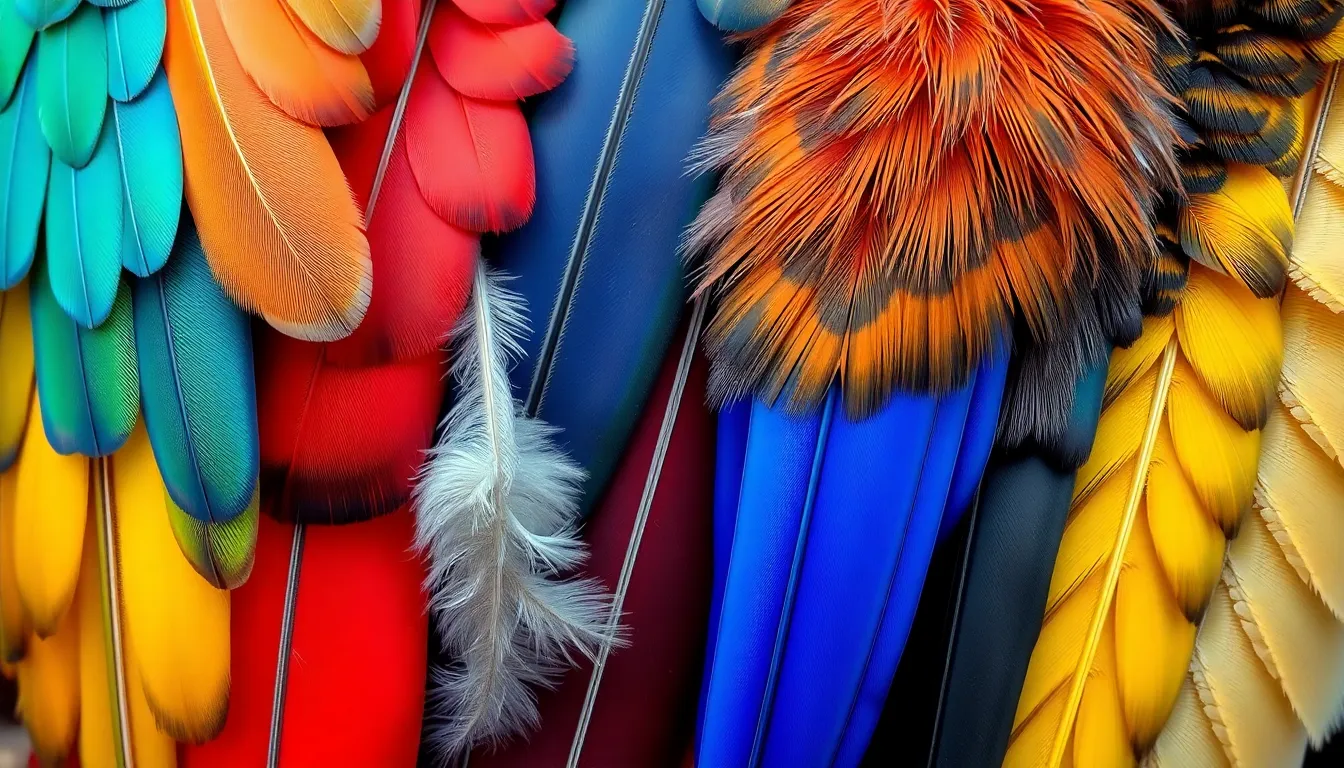
Bird feathers represent one of evolution’s most remarkable innovations, transforming from simple structures into complex systems that revolutionized vertebrate life. This evolutionary journey spans over 160 million years and demonstrates nature’s ability to create multifunctional designs.
Fossil Evidence and Origins
Fossil discoveries reveal that feathers existed long before powered flight emerged in birds. Archaeopteryx, dating back 150 million years, possessed asymmetrical flight feathers similar to modern birds, indicating that feather evolution preceded the development of sophisticated flight mechanics.
Chinese fossil sites have yielded specimens of feathered dinosaurs like Sinosauropteryx and Anchiornis, showing that primitive feather structures first appeared in theropod dinosaurs approximately 160 million years ago. These early feathers consisted of simple filaments called protofeathers, which likely served for insulation and display rather than flight.
Confuciusornis fossils demonstrate intermediate feather development, featuring both primitive and advanced feather characteristics within the same species. Paleontologists have identified multiple evolutionary stages through these specimens, from simple branched filaments to complex pennaceous feathers with interlocking barbule systems.
Recent discoveries in Myanmar amber preserve feather fragments from 99 million years ago, providing direct evidence of ancient feather microstructure. These amber specimens contain melanosomes that produced colors in Cretaceous period feathers, allowing scientists to reconstruct the actual appearance of prehistoric feathered creatures.
Evolutionary Advantages and Adaptations
Feathers provided multiple selective advantages that drove their rapid evolution and diversification across bird lineages. Temperature regulation emerged as the primary evolutionary pressure, with early feathers creating insulating air layers that allowed smaller dinosaurs to maintain stable body temperatures.
Display functions evolved simultaneously with insulation, as colorful feathers attracted mates and established social hierarchies. Modern peacock tail feathers exemplify this evolutionary pathway, where sexual selection drove the development of elaborate plumage patterns that demonstrate genetic fitness to potential partners.
Aerodynamic properties developed through gradual modifications of existing feather structures. Asymmetrical flight feathers evolved from symmetrical display feathers, creating the lift and thrust mechanisms necessary for powered flight. Primary flight feathers became longer and stiffer, while secondary feathers developed exact shapes for maneuverability.
Waterproofing adaptations emerged in aquatic bird lineages through modified barbule structures and specialized preening gland secretions. Duck and swan feathers demonstrate these adaptations, with tightly interlocked barbules creating water-resistant surfaces that maintain buoyancy and insulation in aquatic environments.
Specialized feathers evolved for exact ecological niches, including sound production in woodpecker tail feathers, camouflage patterns in ground-dwelling species, and tactile sensors in nocturnal hunters. Owl flight feathers developed serrated leading edges that eliminate flight noise, providing hunting advantages in darkness.
Functions Beyond Flight

Bird feathers serve critical roles that extend far beyond their aerodynamic capabilities. We discover that these remarkable structures provide essential services including thermal regulation, social interaction, and environmental protection that make survival possible across diverse habitats.
Insulation and Temperature Regulation
Down feathers create exceptional thermal barriers that maintain core body temperature in extreme conditions. We observe these fluffy structures trap air pockets between their loose barbs, forming insulation layers up to 5 times more effective than synthetic materials. Arctic birds like ptarmigans develop dense undercoats containing over 25,000 down feathers per square inch during winter months.
Contour feathers work alongside down layers to regulate heat exchange through controlled airflow. Birds adjust their outer feathers to create ventilation channels during hot weather or compress them against their bodies when temperatures drop. Emperor penguins demonstrate this principle by rotating positions in huddles while their feathers maintain internal temperatures of 98°F even though external conditions reaching minus 40°F.
Specialized blood vessels within feather follicles respond to temperature changes by dilating or constricting blood flow. We find that birds in tropical climates possess fewer down feathers and more loosely structured contour feathers that promote heat dissipation. Desert species like roadrunners orient their back feathers toward the sun to create shade over their bodies while exposing heat-absorbing areas.
Display and Communication
Colorful plumage patterns serve as visual communication systems that convey species identity, reproductive status, and territorial boundaries. We examine how male peacocks display over 200 iridescent eye spots on their tail feathers to attract potential mates during breeding seasons. Northern cardinals maintain their bright red coloration year-round through carotenoid pigments obtained from their diet.
Structural coloration produces brilliant hues without pigments through microscopic feather architectures that reflect exact wavelengths of light. Hummingbird gorgets contain barbules arranged in precise patterns that create metallic flashes visible only from certain angles. We note that these optical effects change dramatically based on viewing position and light intensity.
Feather displays communicate aggression, submission, and alarm states through exact postures and movements. Birds raise their crest feathers when threatened, flatten them against their heads when submissive, or spread wing feathers to appear larger during territorial disputes. Mourning doves produce whistling sounds through specialized flight feathers that warn other birds of potential dangers.
Waterproofing and Protection
Preen glands produce oils that birds distribute across their feathers to create water-resistant barriers essential for aquatic survival. We observe that ducks and other waterfowl apply these secretions systematically, coating over 14,000 individual feathers during daily preening sessions. Their outer feathers shed water completely while underlying down remains dry and insulating.
Barbule microstructures interlock to form continuous surfaces that prevent water penetration through mechanical barriers. Penguin feathers contain three distinct layers with outer contour feathers featuring densely packed barbs that overlap like roof shingles. We find these arrangements direct water away from the body while maintaining structural integrity under diving pressures exceeding 40 pounds per square inch.
Feather density increases dramatically in species exposed to harsh environmental conditions, providing physical protection against wind, debris, and UV radiation. Snowy owls possess feathers covering their legs and feet completely, while most songbirds have exposed tarsi. We measure feather coverage rates of up to 95% body surface area in Arctic species compared to 60% in temperate zone birds.
Feather Color and Patterns

Feather coloration represents one of nature’s most sophisticated visual systems, combining chemical pigments with microscopic structures to create stunning displays. Bird species demonstrate remarkable diversity through their feather patterns, which serve essential functions in survival, reproduction, and communication.
Pigmentation Mechanisms
Melanin pigments form the foundation of most feather colors we observe in birds across different habitats. Eumelanin produces black, gray, and brown tones through dense granule concentrations within feather cells. Phaeomelanin creates reddish brown and yellow hues in species like cardinals and goldfinches.
Carotenoid pigments generate vibrant reds, oranges, and yellows that birds obtain exclusively through their diet. American robins display these carotenoids in their breast feathers, while male house finches show varying red intensities based on carotenoid availability during molting periods.
Porphyrin pigments create unique green and red coloration patterns in exact bird families, including bustards and turacos. These pigments resist fading under ultraviolet light exposure, maintaining their brilliance throughout the bird’s lifetime.
| Pigment Type | Colors Produced | Common Examples |
|---|---|---|
| Eumelanin | Black, gray, brown | Crows, sparrows |
| Phaeomelanin | Red-brown, yellow | Cardinals, canaries |
| Carotenoids | Red, orange, yellow | Robins, flamingos |
| Porphyrins | Green, red | Turacos, bustards |
Structural Coloration
Microscopic feather structures create iridescent colors through light interference and scattering mechanisms. Barbule surfaces contain layers of keratin and air that reflect exact wavelengths while absorbing others. Hummingbirds showcase this structural coloration with their brilliant throat patches that shift colors based on viewing angles.
Coherent scattering produces the vivid blues we see in blue jays and indigo buntings, where no blue pigments exist within their feathers. Peacock tail feathers demonstrate complex structural arrangements that create their famous eyespot patterns through precise barbule alignment.
Thin film interference generates the metallic sheens visible in starling plumage and mallard head feathers. These structures change appearance dramatically under different lighting conditions, serving important roles in species recognition and mate selection.
Seasonal Changes and Molting
Annual molting cycles allow birds to refresh their feather coloration and patterns for exact seasonal requirements. Male mallards develop their distinctive breeding plumage during fall molts, replacing drab eclipse feathers with vibrant green head coloration.
Complete molts replace all feathers systematically over several weeks, while partial molts target exact feather groups like head and body coverts. American goldfinches undergo dramatic transformations from olive winter plumage to bright yellow breeding colors through controlled molting sequences.
Hormonal triggers initiate molting processes, with testosterone and thyroid hormones regulating timing and extent. Nutritional stress during molting periods can result in fault bars or altered pigmentation patterns that persist until the next molt cycle.
Environmental factors influence feather color intensity during development, with temperature and humidity affecting pigment deposition. Arctic birds often display seasonal color changes that provide camouflage advantages, transitioning from brown summer plumage to white winter coloration through specialized molting patterns.
Feather Care and Maintenance
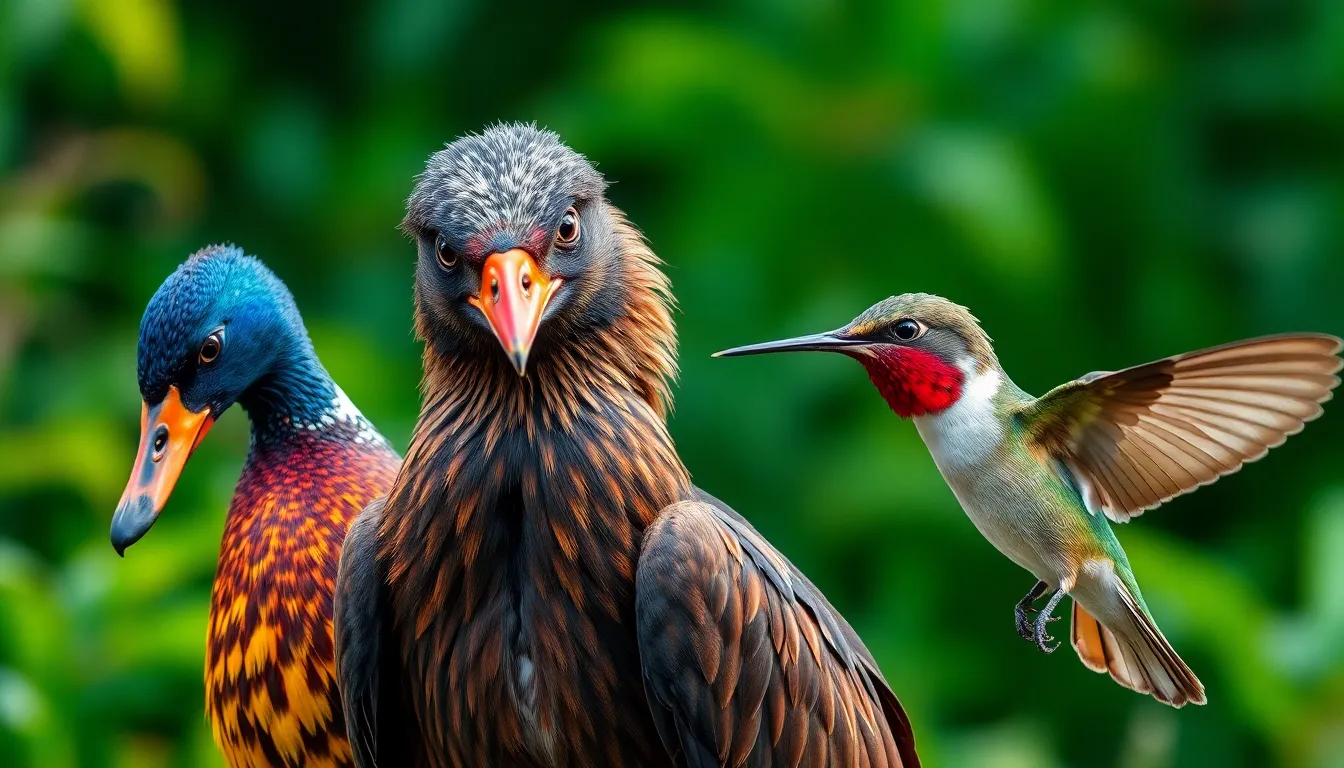
Birds invest important time and energy maintaining their feathers to ensure optimal performance across all their essential functions. Proper feather maintenance determines survival success in everything from flight efficiency to thermal regulation.
Preening Behaviors
Birds dedicate 10-15% of their daily activity to preening behaviors that keep feathers in pristine condition. They use their beaks to align barbules and remove dirt, parasites, and damaged sections from individual feathers. Each preening session involves systematically working through different feather groups, starting with easily accessible areas before contorting to reach wing and back feathers.
Different bird species exhibit distinct preening techniques based on their beak shape and body structure. Waterfowl like ducks perform extensive preening to maintain waterproofing, while hummingbirds use rapid scratching motions with their feet to clean head feathers their beaks can’t reach. Raptors spend considerable time preening flight feathers since even minor damage affects hunting performance.
Social preening occurs in many species where birds clean areas their partners cannot access. Parrots, ravens, and many seabirds engage in mutual preening that also strengthens pair bonds and flock relationships. Birds also perform dust bathing and water bathing behaviors that complement preening by removing excess oils and parasites.
Oil Glands and Natural Conditioning
The uropygial gland located at the base of a bird’s tail produces specialized oils essential for feather maintenance. This preen gland secretes waxy substances containing antimicrobial compounds that protect feathers from bacterial and fungal infections. Birds collect these oils on their beaks during preening and distribute them across their plumage.
Preen gland secretions vary significantly among species based on their environmental needs. Aquatic birds produce oils rich in wax esters that create superior waterproofing, while desert birds generate lighter oils that prevent feather brittleness in arid conditions. Seabirds like petrels and albatrosses have particularly large preen glands that produce oils crucial for oceanic survival.
Chemical analysis reveals that preen oils contain volatile compounds that may serve communication functions beyond feather care. These oils help maintain feather flexibility, prevent UV damage, and preserve structural integrity of barbules over time. Birds without functional preen glands experience rapid feather degradation and compromised waterproofing that can prove fatal in harsh environments.
Human Uses of Bird Feathers
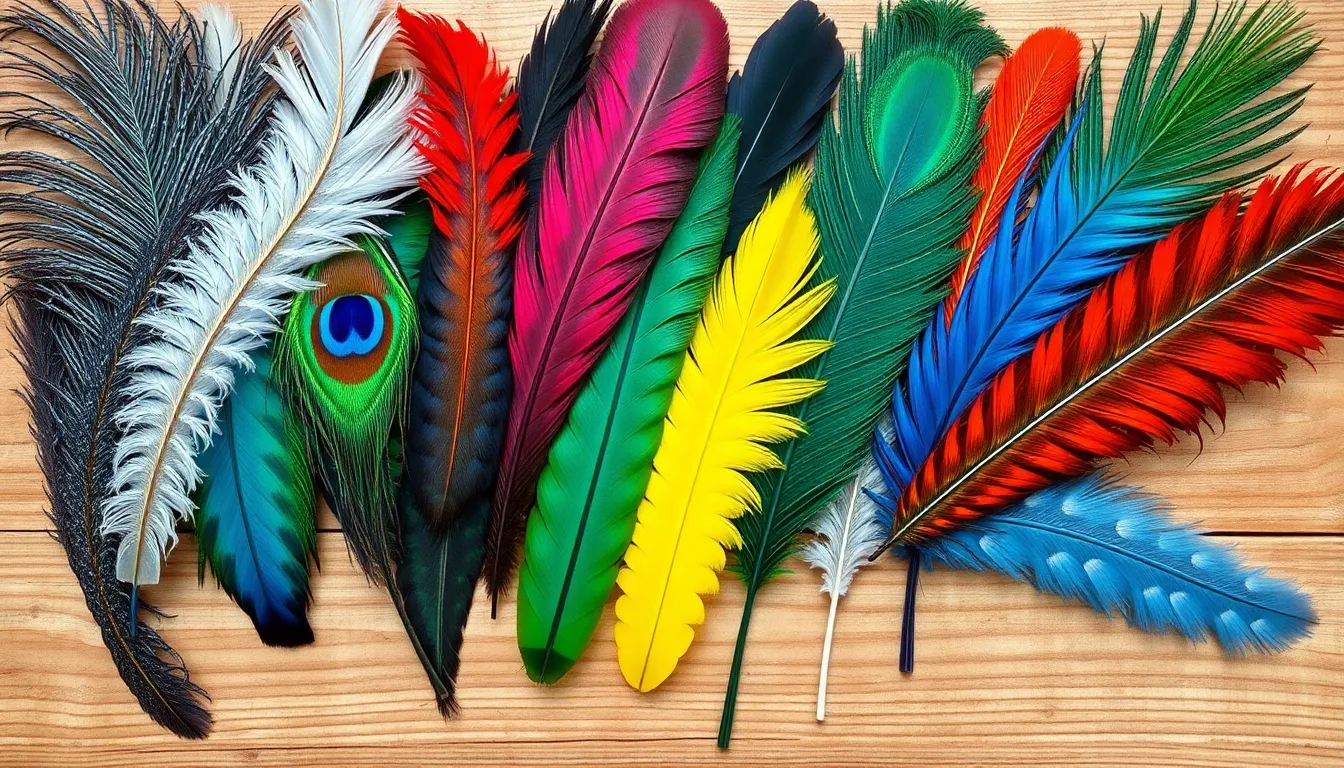
Humans have utilized bird feathers for thousands of years across diverse cultures and applications. These remarkable structures continue to serve practical and aesthetic purposes in contemporary society.
Historical and Cultural Significance
Ancient civilizations incorporated feathers into religious ceremonies, royal regalia, and decorative arts spanning millennia. Egyptian pharaohs adorned themselves with ostrich feathers as symbols of divine authority, while Native American tribes used eagle feathers in sacred rituals representing courage and spiritual connection. Medieval European nobles imported exotic feathers from peacocks, herons, and birds of paradise to demonstrate wealth and status through elaborate headdresses and clothing embellishments.
Warriors across various cultures attached feathers to arrows, shields, and ceremonial weapons for both practical and symbolic purposes. Aztec priests crafted intricate feathered mosaics depicting gods and mythological scenes using thousands of hummingbird and quetzal feathers. Pacific Island societies developed sophisticated feathered cloaks and helmets that indicated social rank and political power within their communities.
Traditional medicine systems incorporated exact bird feathers into healing practices and protective talismans. Chinese medicine practitioners used crane feathers in treatments for respiratory ailments, while European folk healers prescribed swan feathers for various inflammatory conditions. Indigenous Australian cultures employed emu feathers in ceremonial body painting and spiritual cleansing rituals that connected participants to ancestral traditions.
Modern Applications and Industries
Contemporary manufacturing industries use bird feathers in specialized products requiring lightweight insulation and thermal regulation properties. Down feathers from geese and ducks fill premium outdoor gear including sleeping bags, jackets, and comforters that provide exceptional warmth-to-weight ratios. Commercial down processing facilities clean and separate feathers by species and quality grades, with eiderdown commanding prices exceeding $2,000 per kilogram due to its superior insulating capabilities.
Fashion designers incorporate feathers into haute couture collections, theatrical costumes, and luxury accessories through sustainable sourcing practices. Millinery artisans shape ostrich plumes into elegant hat decorations, while costume departments use pheasant and rooster feathers for period films and stage productions. Modern feather processing techniques preserve natural colors and textures while ensuring ethical collection methods that support conservation efforts.
Scientific research applications employ feathers as biological indicators for environmental monitoring and species identification studies. Museums preserve feather specimens in climate-controlled collections that document biodiversity patterns and evolutionary relationships across bird families. Forensic laboratories analyze feather samples to identify species involved in aircraft strikes and wildlife crimes, using microscopic barbule structures and DNA analysis techniques.
| Industry | Feather Type | Annual Volume | Primary Use |
|---|---|---|---|
| Bedding | Duck/Goose Down | 180,000 tons | Insulation |
| Fashion | Ostrich Plumes | 15,000 pieces | Decoration |
| Outdoor Gear | Premium Down | 45,000 tons | Thermal Regulation |
| Museums | Various Species | 2.3 million specimens | Research |
Biotechnology companies study feather proteins to develop synthetic materials mimicking their unique structural properties. Researchers extract keratin from waste feathers to create biodegradable films and composite materials for packaging applications. Aerospace engineers examine feather microstructures to improve turbulence reduction technologies in aircraft design and wind turbine efficiency systems.
Conservation and Ethical Considerations
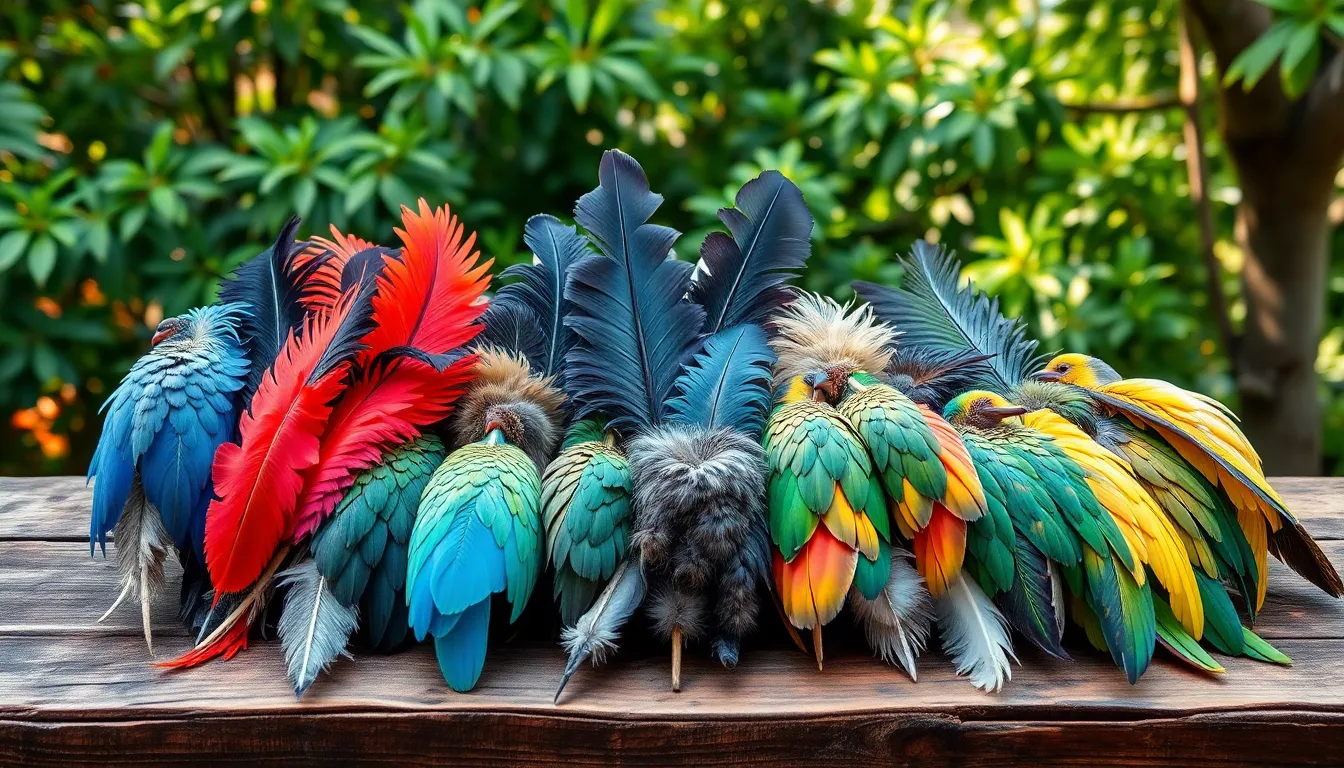
Modern feather collection practices directly impact wild bird populations through habitat disruption and species exploitation. We recognize that commercial feather harvesting has historically contributed to important declines in bird species populations across multiple continents. The global feather trade generates approximately $4.2 billion annually while affecting over 300 bird species through various collection methods.
Legal Protection and International Regulations
International wildlife protection laws establish strict guidelines for feather collection and trade activities. The Migratory Bird Treaty Act prohibits possession of feathers from over 1,000 protected species across North America without proper permits. Convention on International Trade in Endangered Species (CITES) regulations control cross-border feather commerce for threatened bird populations worldwide.
Federal permits require exact documentation for scientific research, educational programs, and cultural ceremonies involving protected bird feathers. We observe that violation penalties range from $5,000 to $250,000 in fines plus potential imprisonment for illegal feather possession or trade activities.
Sustainable Feather Sources
Ethical feather procurement relies on naturally molted specimens and regulated poultry industry byproducts rather than wild bird harvesting. Molted feathers from captive breeding programs provide sustainable alternatives for commercial applications without harming living birds. Domestic poultry operations generate over 2.3 million tons of feather waste annually that can be repurposed for industrial uses.
Licensed wildlife rehabilitation centers collect naturally shed feathers during bird recovery processes. We find that these facilities provide ethically sourced specimens for educational displays and scientific research while supporting conservation efforts.
Impact on Endangered Species
Rare bird species face particular vulnerability to feather collection pressures due to their limited population sizes. Hawaiian bird species like the Hawaiian goose and Hawaiian hawk remain protected under federal law with zero-tolerance policies for feather collection. Tropical parrot populations have declined by 60% since 1970 partly due to feather trade demands in certain regions.
Bird conservation organizations document that illegal feather harvesting contributes to population stress in 47 critically endangered avian species globally. We recognize that enforcement challenges persist in remote habitats where monitoring illegal collection activities proves difficult for wildlife authorities.
Synthetic Alternatives and Innovation
Modern synthetic feather production offers viable alternatives to natural specimens for decorative and industrial applications. Manufactured feathers replicate the structural properties of natural specimens using recycled materials and sustainable production methods. Synthetic feather technology has advanced to achieve 95% visual similarity to natural specimens while eliminating wildlife impact concerns.
Research institutions develop bio-compatible synthetic materials that match the thermal and aerodynamic properties of genuine bird feathers. We observe that synthetic alternatives cost 30-40% less than ethically sourced natural feathers while maintaining comparable performance characteristics.
Conservation Success Stories
Targeted protection efforts have restored several bird species populations previously threatened by feather trade activities. Great egret populations recovered from near extinction in the early 1900s to stable breeding populations exceeding 200,000 pairs across North America today. Conservation programs combining habitat protection with feather trade regulation demonstrate measurable success in species recovery initiatives.
We document that collaborative efforts between conservation groups, government agencies, and indigenous communities create effective protection frameworks for culturally important bird species. These partnerships balance traditional cultural practices with modern conservation science to preserve both bird populations and cultural heritage.
Conclusion
Bird feathers represent one of nature’s most remarkable innovations – a testament to evolutionary brilliance that continues to inspire and amaze us today. Through our exploration of these intricate structures we’ve discovered that they’re far more than simple coverings for flight.
As we observe birds in our daily lives we can now appreciate the incredible complexity hidden within each feather. From the microscopic barbules that create seamless surfaces to the sophisticated color mechanisms that produce stunning displays every aspect serves a vital purpose.
Our responsibility as stewards of the natural industry extends to protecting these magnificent creatures and their extraordinary adaptations. By choosing sustainable practices and supporting conservation efforts we ensure that future generations will continue to marvel at the beauty and functionality of bird feathers.
The next time you spot a bird remember that you’re witnessing millions of years of evolutionary perfection in action.
Frequently Asked Questions
What are the main functions of bird feathers?
Bird feathers serve multiple critical functions including flight, insulation, waterproofing, and communication. They provide the aerodynamic properties needed for powered flight, create thermal barriers to regulate body temperature, protect against water through specialized oils, and display vibrant colors and patterns for species identification and mating displays.
How are bird feathers structured?
Feathers are sophisticated structures made primarily of keratin proteins, making them stronger than steel by weight. They consist of barbules that interlock to create smooth surfaces, contain air-filled spaces for lightness, and include melanin granules for color and durability. Different types include contour, down, flight, semiplume, and filoplume feathers.
When did feathers first evolve?
Feathers evolved over 160 million years ago, existing long before powered flight. Fossil evidence from specimens like Archaeopteryx and feathered dinosaurs such as Sinosauropteryx shows that primitive feathers initially served insulation and display functions before developing into the complex flight structures we see today.
How do birds maintain their feathers?
Birds spend 10-15% of their daily activity preening, using their beaks to align barbules and remove dirt and parasites. They also use oils from their uropygial (preen) gland to maintain feather flexibility, waterproofing, and protection from infections. Social preening also helps strengthen pair bonds between birds.
What creates the different colors in bird feathers?
Feather coloration comes from two main sources: pigments and structural coloration. Pigments like eumelanin, phaeomelanin, carotenoids, and porphyrins create various colors, while structural coloration produces iridescent hues through microscopic feather structures that manipulate light interference and scattering, as seen in peacocks and hummingbirds.
Are there ethical concerns with using bird feathers?
Yes, feather collection can impact wild bird populations through habitat disruption and species exploitation. International regulations like the Migratory Bird Treaty Act and CITES protect endangered species. Sustainable alternatives include using naturally molted feathers, poultry industry byproducts, and synthetic feather alternatives.
How often do birds replace their feathers?
Birds undergo annual molting cycles to replace worn feathers with fresh ones. This process is influenced by hormonal changes, environmental factors, nutrition, and temperature. Molting allows birds to refresh their coloration, maintain optimal feather performance, and adapt to seasonal changes like camouflage needs.
What makes feathers so lightweight yet strong?
Feathers achieve their remarkable strength-to-weight ratio through their keratin protein structure combined with air-filled spaces. The interlocking barbule system creates structural integrity while maintaining flexibility, and the hollow spaces reduce weight without compromising strength, making them ideal for flight and insulation.







